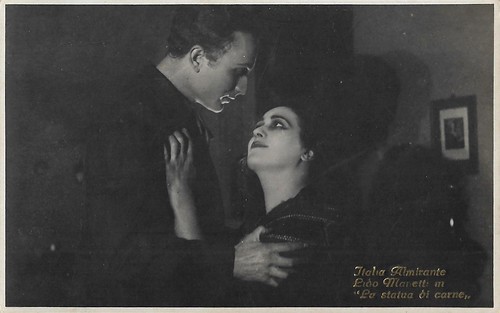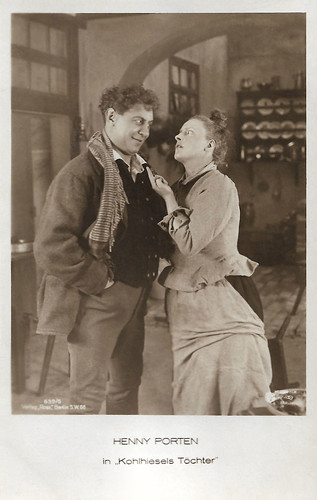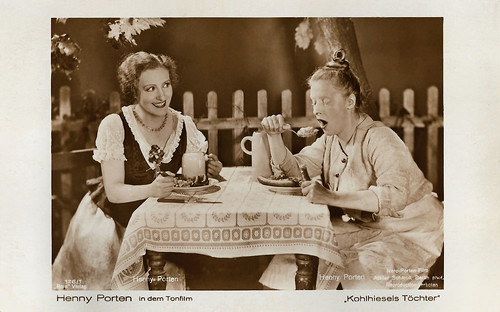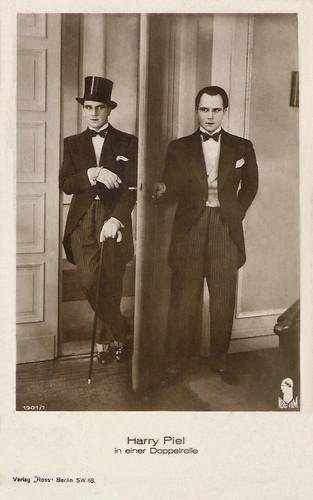What happens when you see your doppelganger? Doppelganger, a loan word from German, stands for the perfect replica. In the cinema, the tradition of the doppelganger is long and varied. Occasionally the doppelganger can be mischievous or a trickster, like Kim Novak in Hitchcock's Vertigo (1958). Often seeing one’s own double is a fearful experience, sometimes even the harbinger of death, such as in the German silent classic Der Student von Prag (1913) with Paul Wegener. And what, if you have a twin and you don't know it, as in the Disney classic The Parent Trap (1961). Hayley Mills played both sisters, which happens to be another tradition in the cinema.

Maria Carmi. German postcard by Verlag Hermann Leiser, Berlin-Wilmersdorf, no. 7267. Collection: Didier Hanson.
Das Mirakel (1912) re-tells an old legend about a nun in the Middle Ages who runs away from her convent with a knight. She has several adventures, eventually leading to her being accused of witchcraft. During her absence, the statue of the Virgin Mary in the convent's chapel comes to life and takes the nun's place in the convent, until her safe return. Then she becomes a statue again. The play's stage director was Max Reinhardt, the Austrian theatrical genius, whose inspired use of lighting, mechanical effects, and spectacle (particularly crowds) startled audiences across Europe. He told the story of Das Mirakel without words in a cathedral setting. 1,000 performers and 500 choristers and 25 horses filled out the epic drama, supported by a wonderful array of stage mechanics, ingenious theatrical effects, and music of the great composer Engelbert Humperdink played by an orchestra of 2,000. For many, the spectacular Das Mirakel was a theatrical event like no other. Das Mirakel/The Miracle was adapted to three different film versions. The original authorised version, The Miracle (1912), was a full-length, hand-coloured film, which was shot in Austria in 1912 but was a British production. Das Mirakel launched the career of Italian silent film star and stage actress Maria Carmi (1880-1957), who interpreted the virgin Mary. With her aristocratic air, her severe looks but also her sweet undertones, Carmi was the cinematic translation of the 19th-century Primadonna.

German postcard by Verlag Hermann Leiser, no. 8579. Photo: Becker & Maass. Publicity still for Das Mirakel/The Miracle with Maria Carmi as the Madonna.

German collectors card by Ross Verlag in the series Vom Werden Deutscher Filmkunst - Der Stumme Film, no. 9. Photo: Sokal-Film. Paul Wegener and Lyda Salmonova in Der Student von Prag/The Student of Prague (Paul Wegener, Stellan Rye, 1913).
In the silent horror classic Der Student von Prag/The Student of Prague (1913), it was the first time you really see the idea of the double on-screen (sadly not on the card). Actor-director Paul Wegener was one of the pioneers of the German cinema who realised the potential of the new medium and used the possibilities of cinematic trick photography as a method for presenting fantastic tales in a serious matter. Audiences flocked to see the film, in part because it tapped into a very real sense of dissociation and alienation inherent in a society that was struggling with the burgeoning collapse of the German empire. Appropriately enough for a film about a double, it was remade at least twice.

Italian postcard by G.B. Falci, Milano, no. 243. Italia Almirante as Maria and Lido Manetti as Paolo La statua di carne/A Statue of Flesh (Mario Almirante, 1921).
La statua di carne vaguely follows the plot of Georges Rodenbach's often adapted novel Bruges-la-Morte (1892). Here a widower is appalled when the lookalike of his chaste wife proves to be a frivolous actress. She mocks the man's cherished braid of his dead wife, so he strangles her with it. The film by Almirante has a less gruesome finale. This card shows a moment in the beginning. Poor Maria is deeply in love with Paolo, at first unknowing that he is a count who pretends to be a poor artist. She will die of tuberculosis, in the arms of Paolo.

Italian postcard by G.B. Falci, Milano, La Fotominio no. 94. Italia Almirante as Noemi and Lido Manetti as Paolo La statua di carne/A Statue of Flesh (Mario Almirante, 1921).
Count Paolo's first night back in society after Maria's death provides him with a shock. He meets an elegant masked lady, Noemi Keller, the toast of the town. She agrees to cheer him up. In a room in the theatre, she takes off her mask and proves to be the spitting image of Maria. He is devastated. She agrees to pose for him every day, even though she knows that he is only thinking of the other woman. Finally, in a duel with a former lover of Noemi, Paolo recognises that he loves Noemi for who she is.

German postcard by Ross Verlag no. 630/2. Photo: Messter Film, Berlin. Publicity still for Kohlhiesels Töchter/Kohlhiesel's Daughters (Ernst Lubitsch, 1920) with Henny Porten as Gretel.
Kohlhiesels Töchter/Kohlhiesel's Daughters (1920) was the most successful film of Ernst Lubitsch's German period. The comedy was extremely popular at the box office and was re-released more than once. It takes its basic premise from William Shakespeare's 'The Taming of the Shrew', relocated to 19th-century southern Bavaria. The sweet-natured young Gretel (Henny Porten) wants to get married to Peter Xaver (Emil Jannings) but her father refuses to allow the match until her elder sister Liesel (also Henny Porten) has married first. As Liesel is notorious for her bad-tempered personality, this is no easy challenge. Xaver's friend Seppel suggests, that Xaver should marry Liesel first, get rid of her, and then marry Gretel...

German postcard by Ross Verlag no. 639/5. Photo: Messter-Film. Emil Jannings as Peter and Henny Porten as Liesel in Kohlhiesels Töchter/Kohlhiesel's Daughters (Ernst Lubitsch, 1920).

German postcard by Ross Verlag, no. 55/5. Photo: A. Schmoll, Berlin / Henny Porten Film. Henny Porten in the film comedy Wehe, wenn sie losgelassen...! /When She Starts - Look Out! (Carl Froehlich, 1926).
Just like she had done before in Kohlhiesels Töchter (Ernst Lubitsch, 1920), Henny Porten again played two parts in Wehe, wenn sie losgelassen: that of a good-looking bourgeois housewife, Cecilia Angeropp, and that of an ugly countryside girl, Liesl, the maid of the other. Porten said herself about this: "I have always had a special preference for double-roles. It was not the masquerades that were particularly appealing to me but the psychological aspects: I wanted to portray two completely different characters to the point that the spectator would as long as possible keep the illusion of both roles being played by two different actresses." Two-shots with both characters within the same shot were obtained with double exposure.

German postcard by Ross Verlag, no. 92/2. Photo Alex Schmoll, Berlin / Henny Porten-Froehlich Produktion. Henny Porten in a double role in Liebe und Diebe/Love and Thieves (Carl Froehlich, 1928).
Baroness Anna von Belling (Henny Porten), who is staying in a posh Wiesbaden hotel, has her jewelry, valuable diamonds, stolen. She personally pursues the thief and is promptly mistaken for an impostor whom the police have long sought. Taken into custody, Ms. von Belling is only released when her own uncle confirms her identity. The hotel guest who, in their eyes, has made himself particularly suspicious, turns out to be a detective and her stolen jewelry proves to be fake. As if by coincidence, the real thief Anna Magdalena Kaludrigkeit, internally called "Brillanten-Anna" (also Porten), appears, who has just returned from a thief tour and has a striking resemblance to her noble namesake. After all the confusion, Baroness Anna and the police commissioner von Langen (Anton Pointner), who handled the case, get closer and get married.

German postcard by Ross Verlag, no. 126/1. Photo: Atelier Schmoll, Berlin / Nero-Porten-Film. Henny Porten in the sound remake Kohlhiesels Töchter/Kohlhiesel's Daughters (Hans Behrendt, 1930).

German postcard by Ross Verlag, no. 887/1. Photo: Bavaria Film. Vladimir Gajdarov in a double role in Hochstapler wider Willen aka Der Doppelgänger des Herrn Schnepfe/Reluctant Imposter (Géza von Bolváry, 1925). The film was shot at the Bavaria Studios in Munich in 1924 and released on 25 February 1925.

German postcard by Ross Verlag, no. 887/2. Photo: Bavaria Film Vladimir Gajdarov in a double role in Hochstapler wider Willen aka Der Doppelgänger des Herrn Schnepfe/Reluctant Imposter (Géza von Bolváry, 1925).

German postcard by Ross Verlag, no. 54/2. Photo: Ufa. Conrad Veidt in a double role in Die Brüder Schellenberg/The Brothers Schellenberg/ (Karl Grune, 1926).
The two brothers in Die Brüder Schellenberg are opposite characters: Wenzel (right) is the gold-digging opportunist, while Michael (left)is the caritative aid to the poor and destitute.

German postcard by Ross Verlag, Berlin, no. 1901/1, 1927-1928. Photo: Nero Film. Harry Piel played a double role in Sein grösster Bluff/His Greatest Bluff (Harry Piel, Henrik Galeen, 1927).
In Sein grösster Bluff, Harry Piel played two twin brothers. A year earlier, co-director Henrik Galeen had made a new version of Der Student von Prag/The Student of Prague (1926), this time with Conrad Veidt as Balduin, the student.

German postcard by Rüdel-Verlag, Hamburg-Bergedorf, no. 533. Photo: Carlton - Film National. Isa and Jutta Günther in Das Doppelte Lottchen/Two Times Lotte (Josef von Baky, 1950).
German twin sisters Isa and Jutta Günther (1938) are former child actresses. In 1950 they were a huge success in the Erich Kästner adaptation Das Doppelte Lottchen/Two Times Lotte. Several more light entertainment films with the twins followed during the 1950s. Das Doppelte Lottchen would be remade by Walt Disney as The Parent Trap (1961).

German postcard by Graphima, Berlin.
Twins became an item in the European cinema of the 1950s and 1960s. Alice & Ellen Kessler (1936) were popular in Europe, especially in Germany and Italy, as a singing, dancing, and acting twin. The German sisters are usually credited as the Kessler Twins or Die Kessler-Zwillinge.

Spanish postcard by Bergas, no. 461.
Blond twin sisters Pili and Mili Bayona (1947) were a popular comedy duo in the Spanish cinema as Pili y Mili. Their films such as the musical comedy Como dos gotas de agua/Like two drops of water (Luis César Amadori, 1963) were engaging examples of European teen pop culture of the 1960s.
Sources: Emma Jones (BBC), Christiane Schönefeld and Hermann Rasche, ed.. (Processes of Transposition: German Literature and Film, 2007), Indiewire, Wikipedia, and IMDb

Maria Carmi. German postcard by Verlag Hermann Leiser, Berlin-Wilmersdorf, no. 7267. Collection: Didier Hanson.
Das Mirakel (1912) re-tells an old legend about a nun in the Middle Ages who runs away from her convent with a knight. She has several adventures, eventually leading to her being accused of witchcraft. During her absence, the statue of the Virgin Mary in the convent's chapel comes to life and takes the nun's place in the convent, until her safe return. Then she becomes a statue again. The play's stage director was Max Reinhardt, the Austrian theatrical genius, whose inspired use of lighting, mechanical effects, and spectacle (particularly crowds) startled audiences across Europe. He told the story of Das Mirakel without words in a cathedral setting. 1,000 performers and 500 choristers and 25 horses filled out the epic drama, supported by a wonderful array of stage mechanics, ingenious theatrical effects, and music of the great composer Engelbert Humperdink played by an orchestra of 2,000. For many, the spectacular Das Mirakel was a theatrical event like no other. Das Mirakel/The Miracle was adapted to three different film versions. The original authorised version, The Miracle (1912), was a full-length, hand-coloured film, which was shot in Austria in 1912 but was a British production. Das Mirakel launched the career of Italian silent film star and stage actress Maria Carmi (1880-1957), who interpreted the virgin Mary. With her aristocratic air, her severe looks but also her sweet undertones, Carmi was the cinematic translation of the 19th-century Primadonna.

German postcard by Verlag Hermann Leiser, no. 8579. Photo: Becker & Maass. Publicity still for Das Mirakel/The Miracle with Maria Carmi as the Madonna.

German collectors card by Ross Verlag in the series Vom Werden Deutscher Filmkunst - Der Stumme Film, no. 9. Photo: Sokal-Film. Paul Wegener and Lyda Salmonova in Der Student von Prag/The Student of Prague (Paul Wegener, Stellan Rye, 1913).
In the silent horror classic Der Student von Prag/The Student of Prague (1913), it was the first time you really see the idea of the double on-screen (sadly not on the card). Actor-director Paul Wegener was one of the pioneers of the German cinema who realised the potential of the new medium and used the possibilities of cinematic trick photography as a method for presenting fantastic tales in a serious matter. Audiences flocked to see the film, in part because it tapped into a very real sense of dissociation and alienation inherent in a society that was struggling with the burgeoning collapse of the German empire. Appropriately enough for a film about a double, it was remade at least twice.

Italian postcard by G.B. Falci, Milano, no. 243. Italia Almirante as Maria and Lido Manetti as Paolo La statua di carne/A Statue of Flesh (Mario Almirante, 1921).
La statua di carne vaguely follows the plot of Georges Rodenbach's often adapted novel Bruges-la-Morte (1892). Here a widower is appalled when the lookalike of his chaste wife proves to be a frivolous actress. She mocks the man's cherished braid of his dead wife, so he strangles her with it. The film by Almirante has a less gruesome finale. This card shows a moment in the beginning. Poor Maria is deeply in love with Paolo, at first unknowing that he is a count who pretends to be a poor artist. She will die of tuberculosis, in the arms of Paolo.

Italian postcard by G.B. Falci, Milano, La Fotominio no. 94. Italia Almirante as Noemi and Lido Manetti as Paolo La statua di carne/A Statue of Flesh (Mario Almirante, 1921).
Count Paolo's first night back in society after Maria's death provides him with a shock. He meets an elegant masked lady, Noemi Keller, the toast of the town. She agrees to cheer him up. In a room in the theatre, she takes off her mask and proves to be the spitting image of Maria. He is devastated. She agrees to pose for him every day, even though she knows that he is only thinking of the other woman. Finally, in a duel with a former lover of Noemi, Paolo recognises that he loves Noemi for who she is.

German postcard by Ross Verlag no. 630/2. Photo: Messter Film, Berlin. Publicity still for Kohlhiesels Töchter/Kohlhiesel's Daughters (Ernst Lubitsch, 1920) with Henny Porten as Gretel.
Kohlhiesels Töchter/Kohlhiesel's Daughters (1920) was the most successful film of Ernst Lubitsch's German period. The comedy was extremely popular at the box office and was re-released more than once. It takes its basic premise from William Shakespeare's 'The Taming of the Shrew', relocated to 19th-century southern Bavaria. The sweet-natured young Gretel (Henny Porten) wants to get married to Peter Xaver (Emil Jannings) but her father refuses to allow the match until her elder sister Liesel (also Henny Porten) has married first. As Liesel is notorious for her bad-tempered personality, this is no easy challenge. Xaver's friend Seppel suggests, that Xaver should marry Liesel first, get rid of her, and then marry Gretel...

German postcard by Ross Verlag no. 639/5. Photo: Messter-Film. Emil Jannings as Peter and Henny Porten as Liesel in Kohlhiesels Töchter/Kohlhiesel's Daughters (Ernst Lubitsch, 1920).

German postcard by Ross Verlag, no. 55/5. Photo: A. Schmoll, Berlin / Henny Porten Film. Henny Porten in the film comedy Wehe, wenn sie losgelassen...! /When She Starts - Look Out! (Carl Froehlich, 1926).
Just like she had done before in Kohlhiesels Töchter (Ernst Lubitsch, 1920), Henny Porten again played two parts in Wehe, wenn sie losgelassen: that of a good-looking bourgeois housewife, Cecilia Angeropp, and that of an ugly countryside girl, Liesl, the maid of the other. Porten said herself about this: "I have always had a special preference for double-roles. It was not the masquerades that were particularly appealing to me but the psychological aspects: I wanted to portray two completely different characters to the point that the spectator would as long as possible keep the illusion of both roles being played by two different actresses." Two-shots with both characters within the same shot were obtained with double exposure.

German postcard by Ross Verlag, no. 92/2. Photo Alex Schmoll, Berlin / Henny Porten-Froehlich Produktion. Henny Porten in a double role in Liebe und Diebe/Love and Thieves (Carl Froehlich, 1928).
Baroness Anna von Belling (Henny Porten), who is staying in a posh Wiesbaden hotel, has her jewelry, valuable diamonds, stolen. She personally pursues the thief and is promptly mistaken for an impostor whom the police have long sought. Taken into custody, Ms. von Belling is only released when her own uncle confirms her identity. The hotel guest who, in their eyes, has made himself particularly suspicious, turns out to be a detective and her stolen jewelry proves to be fake. As if by coincidence, the real thief Anna Magdalena Kaludrigkeit, internally called "Brillanten-Anna" (also Porten), appears, who has just returned from a thief tour and has a striking resemblance to her noble namesake. After all the confusion, Baroness Anna and the police commissioner von Langen (Anton Pointner), who handled the case, get closer and get married.

German postcard by Ross Verlag, no. 126/1. Photo: Atelier Schmoll, Berlin / Nero-Porten-Film. Henny Porten in the sound remake Kohlhiesels Töchter/Kohlhiesel's Daughters (Hans Behrendt, 1930).

German postcard by Ross Verlag, no. 887/1. Photo: Bavaria Film. Vladimir Gajdarov in a double role in Hochstapler wider Willen aka Der Doppelgänger des Herrn Schnepfe/Reluctant Imposter (Géza von Bolváry, 1925). The film was shot at the Bavaria Studios in Munich in 1924 and released on 25 February 1925.

German postcard by Ross Verlag, no. 887/2. Photo: Bavaria Film Vladimir Gajdarov in a double role in Hochstapler wider Willen aka Der Doppelgänger des Herrn Schnepfe/Reluctant Imposter (Géza von Bolváry, 1925).

German postcard by Ross Verlag, no. 54/2. Photo: Ufa. Conrad Veidt in a double role in Die Brüder Schellenberg/The Brothers Schellenberg/ (Karl Grune, 1926).
The two brothers in Die Brüder Schellenberg are opposite characters: Wenzel (right) is the gold-digging opportunist, while Michael (left)is the caritative aid to the poor and destitute.

German postcard by Ross Verlag, Berlin, no. 1901/1, 1927-1928. Photo: Nero Film. Harry Piel played a double role in Sein grösster Bluff/His Greatest Bluff (Harry Piel, Henrik Galeen, 1927).
In Sein grösster Bluff, Harry Piel played two twin brothers. A year earlier, co-director Henrik Galeen had made a new version of Der Student von Prag/The Student of Prague (1926), this time with Conrad Veidt as Balduin, the student.

German postcard by Rüdel-Verlag, Hamburg-Bergedorf, no. 533. Photo: Carlton - Film National. Isa and Jutta Günther in Das Doppelte Lottchen/Two Times Lotte (Josef von Baky, 1950).
German twin sisters Isa and Jutta Günther (1938) are former child actresses. In 1950 they were a huge success in the Erich Kästner adaptation Das Doppelte Lottchen/Two Times Lotte. Several more light entertainment films with the twins followed during the 1950s. Das Doppelte Lottchen would be remade by Walt Disney as The Parent Trap (1961).

German postcard by Graphima, Berlin.
Twins became an item in the European cinema of the 1950s and 1960s. Alice & Ellen Kessler (1936) were popular in Europe, especially in Germany and Italy, as a singing, dancing, and acting twin. The German sisters are usually credited as the Kessler Twins or Die Kessler-Zwillinge.

Spanish postcard by Bergas, no. 461.
Blond twin sisters Pili and Mili Bayona (1947) were a popular comedy duo in the Spanish cinema as Pili y Mili. Their films such as the musical comedy Como dos gotas de agua/Like two drops of water (Luis César Amadori, 1963) were engaging examples of European teen pop culture of the 1960s.
Sources: Emma Jones (BBC), Christiane Schönefeld and Hermann Rasche, ed.. (Processes of Transposition: German Literature and Film, 2007), Indiewire, Wikipedia, and IMDb
No comments:
Post a Comment